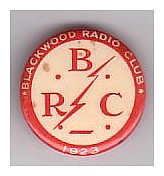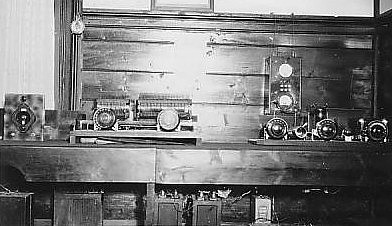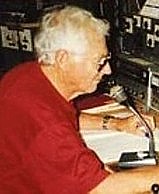
THE BLACKWOOD RADIO CLUB
Early history of the first amateur radio club to be established in South Australia

THE BLACKWOOD RADIO CLUB
Early history of the first amateur radio club to be established in South Australia
BY LLOYD BUTLER VK5BR
First published in "Amateur Radio" March 1991
Introduction
The period around 1920 to 1930 was an exciting time in the development of wireless communications and radio broadcasting and many keen people were attracted to experimentation with wireless or radio equipment. During this period, numerous radio clubs were formed in the Adelaide metropolitan area and in the country areas of South Australia. It is believed that some 20 or more clubs were formed. The Blackwood Radio Club had the honour of being the first amateur radio club to be formed early in 1923. The club remained active to around 1937. However, it was not until 1983 when club activity based in Blackwood was again revived. A new club was then formed called The Adelaide Hills Amateur Radio Society.
This article outlines some of the history of the Blackwood Radio Club. This history has been assembled from various sources such as the club station logbooks, and the good memory of a remaining foundation member, Gordon Ragless.
Formation
The Blackwood Radio Club was formed by Owen Griffiths, Gordon Ragless VK5GR and Robert Ragless, with its headquarters at the Griffiths home at Young Street, Blackwood. The club affiliated with the WIA in November 1924 and, during the period of its existence, a number of its executive members served on the SA Division council of the WIA. (In fact, member Don Elliott served as a Divisional President).
Owen Griffith was the first secretary of the club and we was succeeded by Jack Ferry and then Ford Wells. Presidents included L H Griffiths (Owen's father) and Bert Lampe. Some of the other members were Robert Ragless, Don Elliott VK5RD, Arthur Baust, Harry Wheeler VK5HW, Lionel Badenoch VK5LB, Keith Mutton VK5ZY, Jack Hume, Erne Hume, Percy Deer VK5DR and Ivan Banyer (who had the very early callsign of XVQ,dated back to around 1913). Other names will appear as the article progresses.
The club was granted a transmitting licence and first went to air in August 1926. Transmissions were on the 200m band and the original callsign was A5BR. The callsign became 0A5BR in 1927 and VK5BR in 1929. The significance of those early callsign prefixes is that "A" stood for Asia, and "OA" for Oceania Australia. The VK eventually became the internationally agreed prefix for Australia.
Station VK5BR operated on the 200m band until October 1932 using the station for both communication with other experimental stations and for experimental broadcasting. The logbooks show that wavelengths between 170 and 200 metres were used. The experimental transmissions were restricted to times when the A and B class stations were closed down, essentially on Sunday mornings and after 10pm in the evening.
Transmissions first commenced from the Young St headquarters with a transmitter that used a split series Hartley oscillator with Telefunken system of modulation. Input power to the transmitter was only 3W, but good reports were received as far afield as Moonta and Kadina. Recorded music was played from a phonograph acoustically coupled into the microphone. Some years later this was replaced by a Bosch electromagnetic pickup.
The transmitter was soon upgraded to a Colpitts master oscillator using a UX201A valve driving a UX210 valve as an amplifier. This was Heising modulated with a Philips A630 valve (later changed to a B605 valve). Input power to the amplifier was 8W.
Construction of the original club station transmitter and receiver was essentially carried out by Owen Griffiths. Later construction was carried out by Jack Ferry.
A shortwave transmitter was first made up in 1928 by Don Elliott VK5RD. This used a split series Hartley circuit with 250V on a UX210 valve running 40mA to provide 1OW of input power. A rough sketch of the circuit was made by Don in the VK5BR log and a copy of this is shown in figure 1. The shortwave receiver was constructed from the popular Schnell circuit consisting of a regenerative detector and two stages of audio. The circuit diagram for this was found in a section of the Blackwood Radio Club correspondence and the diagram is reproduced in figure 2.The antenna used with the original shortwave equipment was Zepp fed.
 First short wave transmitter as recorded in the VK5BR log by Don Elliot VK5RD. (reproduced exactly as drawn) |
 The Schnell receiver used by VK5BR as recorded in the Blackwood Radio Club files. (reproduced exactly as drawn) |
Figure 3 is a photograph of what is thought to be the VK5BR transmitting equipment at Clapham around 1931. On the left, with the large coils, is the 200m MOPA transmitter. The right-hand unit appears to be the HF transmitter.
 |
Early transmitting equipment (thought to be VK5BR when operating from Clapham around 1931). |
Operations
The first shortwave contacts were made by Don Elliott in January 1928 on 32m and using the CW mode. Communication was set up for every Friday evening between 7pm and 11pm. Contacts were made with interstate and overseas stations.
Between October 1932 and January 1934 there appears to have been a break in the operations of VK5BR. Transmissions recommenced in January 1934 on the 80m band using the precise frequency of 3.593kHz. This continued until April 1935.
At some stage, the club must have further upgraded its transmitter to around 30W input. The log records figures of 600V at 50mA as early as April 1930. The precise frequency of 3.593kHz also indicates that they had probably changed to crystal control.
The club station shifted its location a number of times. It was first located at Young St, Blackwood, and then at Waite St, Blackwood, both the Griffiths residences. Around 1930, it was relocated to the home of Jack Ferry in Clapham and, around 1934, to the home of the Hume family at Parkside. This was also the original location of Broadcast Station 5DN, established by the Hume family. After 1935, the equipment was not operated, and some of it was stored at the home of Gordon Ragless. What fate it ultimately met is not clear.
During the period 1926-1929, frequent operators of the club station were Owen Griffiths, Gordon Ragless, Ford Wells, Robert Ragless and Don Elliott. Frequent announcers when the station broadcast were Owen Griffiths, Jack Ferry, Harry
Wheeler, Oswald Ragless, Frank Hill, Robert Ragless, Ford Wells, Douglas Wright, John Messer, Milton. Trott, Sid Maag, S Macey and H Naughton. The club also introduced its own studio orchestra. A humorous sketch of this orchestra in performance was prepared by Max Ragless around 1927. The original sketch is kept by Gordon Ragless and a copy of this is shown in figure 4. Here is shown Bob Ragless, Oswald Ragless and Jack Ferry playing the instruments, with Frank Hill singing.
 |
|
A sketch of the Blackwood Radio Club Orchestra, prepared by Max Ragless around 1927. Standing is Bob Ragless playing the clarinet. Sitting is Jack Ferry playing the saxophone. Oswald Ragless plays the banjo. Frank Hill is shown singing. (In later years, Max Ragless became a well known artist.) . |
During the early years, contacts were made with many other stations, but not all of these were licensed. Many came under the category of`what was known as an IWW, which stood for "iIlicit Wireless Worker" or, in the words of Gordon Ragless, 'I Wonder Who". They are more commonly known today as pirates.
In the period 1930-1932, station operators were Jack Ferry, Ford Wells, Lionel Badenoch, Frank Hill, Jim Drummond, Ron Wauchope, Erne Hume and Milton Trott. From 1934 at the Parkside location, operators were Ford Wells, Frank Hill, Erne Hume, Jack Hume and Jim Drummond. Figure 5 shows a QSL card from VK5BR for a contact in this period on 80m. This demonstrates that, at that time, the RF power amplifier was push/pull 46 tubes with 500V on their plates running an input power of 10W. Grid modulation was used and the antenna is some form of Marconi.
The second card (figure 5a) initiated from the earlier period when the call sign prefix was "OA".
|
|
It is interesting to observe how so many amateur radio experimenters turned to radio as a career and often the reverse. Some of the operators of the club station sought a career in radio broadcasting. Erne Hume was chief engineer at station 5DN from 1925 to 1941. He designed much of the transmitting and studio equipment used at that station, and designed the original transmitter at 5RM Renmark. Jack Hume was an announcer at 5DN for some years and was involved in other broadcasting activities such as writing plays. Frank Hill and Ford Wells became members of the technical staff at 5DN and 5RM.
Other Activities
For about four years around 1931 to 1935, the club published an official organ called "KEY-KLIX", and this was edited by Ford Wells. A typical issue for February 1932 included an editorial, a technical article on television by Harry Wheeler VK5HW, shortwave notes by Gordon Ragless VK5GR and other features. As with our clubs of today, the Blackwood Radio Club arranged for interesting technical lectures at its meetings and arranged for visits to such places as Radio Station 5DN, the Unley Telephone Exchange, the Adelaide Observatory and the Hackney Tram Depot. It also organised social events such as the Blackwood Radio Club picnic and other field days. One of the field days included a visit to Kangaroo Island via the old SS 'Karatta' to visit a radio amateur on the island. According to Milton Trott, this turned out to be rather a rough voyage. Another activity was the provision of radio for the Adelaide rowing event, Henley on Torrens.
 |
|
Combined field day of Blackwood Radio Club, Northern Districts Radio Club & Eastern Districts Radio Club held one Saturday near Eden Hills Railway Station. Keith Mutton VK5ZY (BRC), a NDRC member, Doug Merry (NDRC), a NDRC member. Bottom row from left - Bob Ragless (BRC), Keith Litchfield (EDRC), Owen Griffiths (BRC), Bill Harmer (EDRC), Dick Whitington (NDRC), Clive George (EDRC). |
Keith Mutton VK5ZY was able to supply a group photograph taken by Gordon Ragless at an early field day around 1923. (Refer figure 6). A copy, probably supplied by Gordon, was also found in the Mitcham Library archives. The field day was a combined event of the Blackwood Radio Club, the Northern Districts Radio Club and the Eastern Districts Radio Club. In the centre of the photograph is a transmitter which used a single early Mullard ORA valve. (ORA stood for Oscillator Rectifier Amplifier). Individuals in the group, with headphones fitted, had simple receivers which were used to detect signals from the transmitter. The object of the field day exercise was to see how far away they could go and still pick up the signals.
For many years, the Blackwood Radio Club ran a monthly dance which was held at the Eden Hills Parish Hall. It also held an annual radio concert at the Boys Club Hall in Blackwood. From all accounts, the Blackwood Radio Club became quite a social organisation, with social and not just technical type of membership.
The club ceased to be active around 1937, a little before the start of World War 2. The club was not reactivated after the war and its callsign VK5BR was allowed to lapse. The callsign was reallocated to Lloyd Butler in January 1946 and still remains in his hands.
VK5GR
We have been fortunate to have club foundation member Gordon Ragless still with us to verify some of the facts presented in the article. Gordon operated his own station VK5GR and a photo of Gordon and his early amateur radio equipment is shown (refer figure 7). A further recent photograph (figure 8) shows Gordon with his early transmitter and the original VK5BR microphone. Gordon's transmitter is now an exhibit at the Adelaide Telecommunications Museum. The VK5BR microphone case is held by the Adelaide Hills Amateur Radio Society. (Addendum Jan 2002: The Telecommunications Museum was closed some years ago and its exhibits are now held in storage. It is hoped that one day a new home will be found for exhibit display.)
|
|
With 67 years elapsed (as at 1991) since the Blackwood Radio Club was, formed, and 54 years since it ceased to function, it is not surprising that there are now few of its members to be found. However, in addition to Gordon, we were able to contact Keith Mutton VK5ZY, Jim Drummond and Milton Trott, who were also members in the very early years of the club and who were able to add a few details for this article.(Addendum: After this article was first published in 1991, early member Frank Hill VK2HQ read the article and also contacted the writer from Milton NSW ).
Writer's footnote:
It is pure coincidence that I was issued with the callsign VK5BR in 1946, and at that time I had no idea that the callsign had such an historic background. However, this gave me an incentive to find out more about its early history. What you have read now records in print the information, such as in the good memory of Gordon Ragless, who was still around when this article was written, but later passed away in 2002 at the age of 92 years.
Lloyd Butler VK5BR

|
Updated December 21, 2010. |